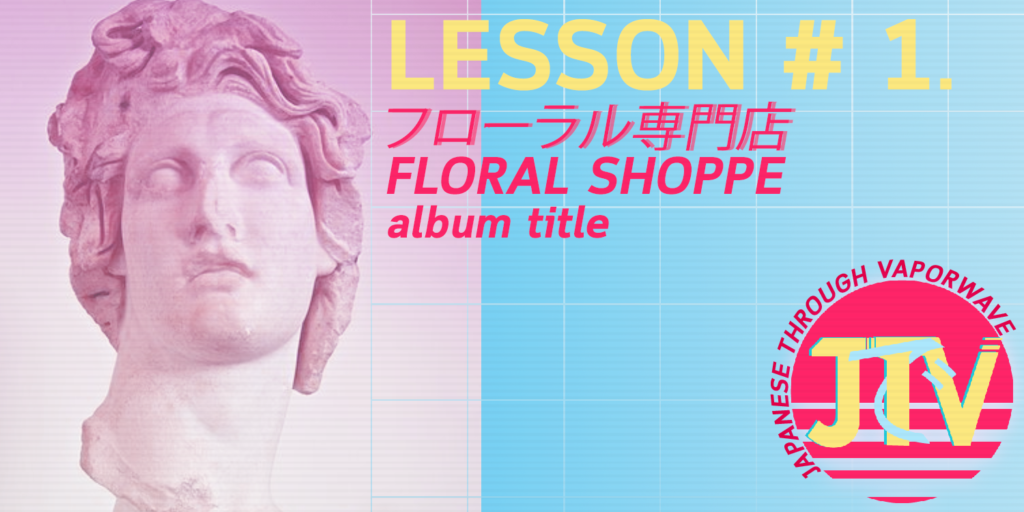
Japanese Lesson #1 – Floral Shoppe
When embarking upon your journey toward the Japanese language through the Vaporworld, there is no better place to begin than Floral Shoppe. Considered by many to not only be the origin of vaporwave as a real genre, but also of the ubiquitous Japanese text motive, Floral Shoppe has truly achieved a legendary status. It would be difficult to find anyone in the Vaporworld not also familiar with this album.
Because of that, the first portal we’re going to leap through is Macintosh Plus’s Floral Shoppe.
You can listen to the album here.
In this first lesson, we will take a close look at the Japanese text on the cover of the album, and by doing so will come to learn about the Japanese ”の” particle and will be introduced to the concepts of Japanese katakana and kanji. Let’s initialize!
First, the iconic album art freaturing the Helio bust. The original 2011 album art features two bits of Japanese text near the top:
MACプラス
フローラルの専門店
プラス reads PU-RA-SU (plus) in katakana, which is one of the two Japanese syllabic scripts (the other is hiragana). Katakana is usually reserved for foreign loan words like アルバイト (arubaito – from arbeit in German – it means part-time work in Japanese) and バックミュージック (bakkumuujikku – back music, or background music), as well as for names, emphasis, onomatopoeia, among other things. It’s use is similar to italics in English, if italics were another alphabet entirely!
フローラルの専門店 (フローラルのせんもんてん – furooraru no senmonten) is a literal translation of the album name, Floral Shoppe.
フローラル (furooraru) is another katakana rendering of a foreign word, like we just encountered. This is of course a katakana version of “floral”, as in the title of the album.
専門店 (せんもんてん – senmonten) refers to a specialty store that stocks mostly items of a similar kind. In this case, our 専門店 is a フローラル specialty store – a floral store or, a Floral Shoppe! As a side note, sometimes “shop” is spelled as “shoppe” in English because it’s an older, more artistocratic-looking way of spelling the word, giving a store a more of an authentic feeling, I suppose. The same meaning isn’t really conveyed in 専門店, which is just literally a specialty store.
Kanji:
We mentioned that Japanese has two syllabic scripts. Well, backup your harddrive, because things are about to get even more fragged up. Japanese also makes use of Chinese characters, called kanji (漢字), and there’s over 2,000 of them in common use in Japan. The more you learn Japanese, however, the more useful you’ll begin to find this aspect of the language. Being able to read lots of data in a single character can be very useful! It’s paticularily useful for making short track titles, as we’ll find later on. And since the Japanese language doesn’t use spaces (“ “), kanji is an essential way of making it so the Japanese language doesn’t just look like a long string of nonsensical text. Granted, if this is your first time studying Japanese, that’s how it probably looks anyway! But good things come to those who persist! Don’t give up! This article is your first step on the journey toward fluency!
の:
One more note – those students with more processing power may have noticed the の symbol connecting the two words in Floral Shoppe’s Japanese title. What’s the meaning of this!? Were you baffled!? What part of the title “Floral Shoppe” could this mysterious symbol possibly connect with?
The answer is quite simple, thankfully. の (no, pronounced as in the statement “NO! Floral Shoppe Cassettes are all sold out!”) is a particle in Japanese – like the words “of”, “from”, “to”, “at” in English. Simply put, the の particle is used to connect nouns in Japanese. More specifically, in this case, it is acting as a modifying particle. That just means it’s giving us more data about the main word, which is 専門店 which, remember, translates as “specialty store”.
So! What kind of specialty store are we dealing with? We’re dealing with a フローラル (floral) speciality store.
フローラル の 専門店
(floral no shop)
In English, this construction can be represented as
Shop of floral
Here “of” is acting as the modifier for shop. Note how the construction is reversed in English, where the main noun comes first. This holds true in other examples, such as:
(ice no lake)
Lake of ice
(Japan no music)
Music of Japan
The important thing to remember is that の usually is found connecting two nouns together, with the last noun being the most important one.
Next lesson, we’re going to look at the tracks on the album individually, and put our new knowledge about katakana, kanji, and the の particle to the test! Please don’t overload with excitement! Can’t wait to see you there! exit(0)
– MEZ